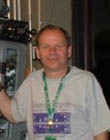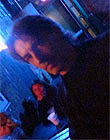|
|
This topic comprises 2 pages: 1 2
|
|
Author
|
Topic: Dual groove records (and other vinyl tricks)
|
|
|
|
|
|
|
|
|
|
|
|
|
|
|
Leo Enticknap
Film God

Posts: 7474
From: Loma Linda, CA
Registered: Jul 2000
|
 posted 05-07-2014 01:26 PM
posted 05-07-2014 01:26 PM





Thanks. According to Wikipedia, the reason was to improve tracking accuracy (i.e. reduce the risk of the needle jumping, I guess) on the inner grooves rather than audio quality. The audio quality reason only makes sense if the groove pitch was cut the same throughout the disc. Certainly on a consumer record (even '20s and '30s shellac ones) this wasn't the same: the cutting lathe gradually increased the pitch the nearer to the center you got, to maintain an even frequency response throughout the running time of the side. I know that Vitaphone tried to reduce surface noise by using a softer shellac/filler compound than was typically used for consumer records, hence the requirement for a new steel needle for each playing, and the reason why Vitaphone discs had check boxes on the label and each side was only supposed to be played a couple of dozen times before the record was discarded. Maybe the softer substrate made it impossible to vary the groove pitch on a Vitaphone mastering for some reason.
Incidentally, when sound on disc was in its death throes in the early '30s (after it had been abandoned for production but distributors were still pressing discs because of contractual obligations to theaters that had installed equipment), several distributors tried to save money by pressing standard 12" discs on the same substrate used for consumer ones - they were pressed by the same plants. They still played from the inside out and ran at 33.3 RPM, though. I've got one record consisting of two reels of The Private Life of Henry VIII in my collection and, as you'd expect, the audio quality on it is horrid - let's just say it has a noise-to-signal ratio! I suspect that one of the reasons they were pressing cheap and nasty records towards the end was as a subtle way to persuade the remaining sound-on-disc theaters to buy optical heads.
| IP: Logged
|
|
|
|
|
|
|
|
|
|
|
|
Leo Enticknap
Film God

Posts: 7474
From: Loma Linda, CA
Registered: Jul 2000
|
 posted 05-08-2014 10:16 AM
posted 05-08-2014 10:16 AM





Single-sided Vitaphone discs could have been to avoid confusion, though I'm wondering if there was print-through / audio quality issue instead or as well.
The substrate of 78s for sale to consumers was a proprietary cocktail consisting of shellac, a resin and a filler. Each pressing plant used its own cocktail. The harder the compound used, the more durable they were (i.e. the more playings they would withstand). The softer the compound, the less surface noise there was (hence a better s/n ratio), and, although this benefit was very marginal, the disc was slightly more difficult to break accidentally. However, a softer compound meant the record wore out more quickly, too - even under ideal playing conditions, pre-microgroove records had an expected lifetime of only a few dozen playings before you started to hear them deteriorate. An acoustic phonograph pickup had a tracking weight measured in pounds, and a pre-microgroove electric one in ounces. Nowadays, 5 grams is considered heavy!
Different manufacturers went for different compromises on the durability vs. audio quality trade-off. That's why you'll hear a lot less surface noise on a 1930s Columbia than you will on an HMV assuming that both are in a similar state of wear, but it's also why good Columbias are harder to find when sifting through the record section in the thrift store.
Vitaphone took an extreme approach to this problem, using a very soft compound to maximise sound quality. They figured that for a recording to be played back to 2,000 people in a prestige theater, the extra cost of replacing a record every 24 playings was worth it. That having been said, I don't know if pressing single-sided records was because of print-through issues in pressing that compound double-sided, or, as you say, to avoid confusion resulting in the wrong side being played.
I do know that as sound-on-disc withered on the vine, economies were made: first the records went double-sided, then 12-inch. At some point the mixture became tougher, too, so that the record was supposed to last the lifetime of the reel of print it came with, unless it was accidentally broken. Towards the end, one or two distributors (I forget which ones) experimented with early vinyl, too, to avoid the breakage risk.
quote: Scott Norwood
As for inside-out grooves being unpopular on consumer records: this might be partially because many consumer turntables have an auto-stop mechanism...
Good point. I once had a Goldring Lenco GL78, which was the only hifi turntable (as distinct from cheap record player with integrated amp and speakers) I ever came across that had an auto-arm lift mechanism. It couldn't cope with 8" and 7" 78s with the tiny labels - the arm would lift with about 20 seconds of playing time still to go.
quote: Scott Norwood
Do they still make large-hole 45RPM 7" disks of popular songs for jukeboxes? That business was alive and well for the entire decade of the '90s, at least. Or are modern jukeboxes just glorified Ipods?
The only newly pressed records I ever buy are LPs (and even then very rarely, because used ones that can be restored to near-new condition merely by washing in a distilled water and IPA solution of the sort of music I like can still be had for next to nothing), so I don't know. Originally, the large hole was an RCA patent, and the small hole (same size as in LPs) Columbia. RCA originally produced turntables (like this one), that would play a box set of 45s, in which an entire symphony or jazz concert was split into four-minute chunks. I've got a few of these sets, and subjectively to me, the audio quality of them is far better than that of the really early Columbia LPs.
Record-playing jukeboxes, however, seem to be acquiring a sort of retro chic. Someone I knew back in York ran a cafe that had a 1930s vintage jukebox that played 10" 78s. It had sat inactive for many years (she regarded it as a piece of curiosity furniture, basically) before she asked me if it could be coaxed back to life. I was astonished to find that the machine-specific spares I needed to do this - some styli, some bulbs and two tubes, basically - were easily available on Ebay. Properly restored jukeboxes from this era go for four figures, and records to play on them in good condition seem to be creeping up in price, too. The only problem with my friend's machine was that the coin acceptor took farthings (a type of British coin that ceased to be legal tender in 1961, and which was worth a quarter of a pre-decimalisation penny, or one 960th of a pound!), and so she had to put it on free play.
| IP: Logged
|
|
|
|
|
|
All times are Central (GMT -6:00)
|
This topic comprises 2 pages: 1 2
|
Powered by Infopop Corporation
UBB.classicTM
6.3.1.2
The Film-Tech Forums are designed for various members related to the cinema industry to express their opinions, viewpoints and testimonials on various products, services and events based upon speculation, personal knowledge and factual information through use, therefore all views represented here allow no liability upon the publishers of this web site and the owners of said views assume no liability for any ill will resulting from these postings. The posts made here are for educational as well as entertainment purposes and as such anyone viewing this portion of the website must accept these views as statements of the author of that opinion
and agrees to release the authors from any and all liability.
|

 Home
Home
 Products
Products
 Store
Store
 Forum
Forum
 Warehouse
Warehouse
 Contact Us
Contact Us




 Printer-friendly view of this topic
Printer-friendly view of this topic










![[Smile]](smile.gif)




![[Big Grin]](biggrin.gif)






